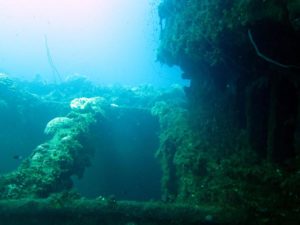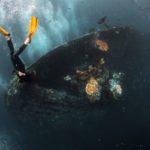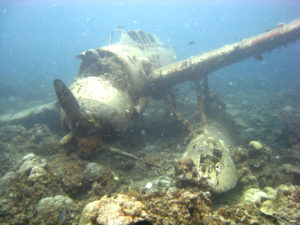Wreck divers take note: we're about to start a six-part series on the world's most dive-able wrecks. We're starting with the best wreck diving in Asia, but stay tuned for articles on the U.S., Africa, Caribbean, Middle East and Europe over the next few weeks. For those who are properly certified, wreck diving can offer a window into history. These spaces are often eerie and mysterious, sometimes dark and gloomy, and always fascinating to explore. Here are our top 10 picks for some of the best wreck diving in Asia.
Fujikawa Maru

Where: Truk (Chuuk) Lagoon, Chuuk
We've written extensively about Chuuk, and for good reason. There are so many dive-able wrecks here it's hard to pick just one, but if we must, it's the Fujikawa Maru. Converted from a cargo ship into an armed aircraft transport ferry by the Japanese Imperial Army, it went down during Operation Hailstone, when American forces attacked the Japanese fleet moored in Truk Lagoon.
The bow gun, fighter-plane fuselages and plane parts in the holds are all highlights. Check out the coral-covered telegraph annunciator and the famous air compressor nick-named R2D2. Qualified divers can penetrate the engine room via the staircase, though should take extreme care as part of the engine room has collapsed. There are also lots of small artifacts like gas masks, Mitsubishi aircraft wings and Zero fighter propeller blades. In 1974 a Japanese delegation placed a glass shrine with the crew members' names on top of the bridge. The wreck is covered with beautiful hard and soft coral.
Depth: 30 to 115 feet (9 to 33 m)
Required qualification: The Fujikawa Maru is accessible to open water, advanced and technical divers with wreck certifications.
USS New York
Where: Subic Bay, Philippines
The USS New York made its maiden voyage in 1891 but was later commissioned for World War I. During this time, it escorted a convoy to France and assisted a British vessel after a German U-boat attacked. Early in 1932, the USS New York served in the Pacific fleet and was decommissioned a few months later. It was scuttled in Subic Bay in 1941 to prevent capture by the Japanese. The wreck is around 380 feet (117 m) long.
The wreck lies on its port side, with four huge, turreted deck guns and a propeller visible. Dense green algae are suspended in the water around the wreck. You might also spot large barracuda and perhaps even an eagle ray around the wreck.
Certified wreck divers can explore up to linear 130 feet (40 m) from the surface and must remain in the light zone, but this does allow them to enter the boiler room and part of the gun deck. Experienced, certified technical divers can explore further afield but must exercise extreme caution as there are blocked passages and extreme conditions.
Depth: 52 to 100 feet (16 to 30 m)
Required qualification: Advanced, wreck-certified divers can do limited penetration. Technical divers can fully penetrate the USS New York.
USAT Liberty

Where: Tulamben Bay, Bali, Indonesia.
The USAT Liberty sits just offshore in sleepy Tulamben Bay, Bali. A Japanese submarine fired two torpedoes at the ship while it was crossing the Lombok Strait in 1942, but it didn't go down. Two tugboats towed it to the beach at Tulamben where it sat, decaying on the shore until 1963 when an earthquake pushed it into the ocean. The wreck, now sitting on a sandy slope in 13 to 100 feet (4 to 30 m) of water, is 411 feet long (125 m) and rests on its right flank.
Coral and fish life cover the Liberty, and a number of humphead parrotfish, schools of trevally and leaf scorpionfish make their home there as well. The wreck is slowly disintegrating but you can still penetrate some of the cargo holds. You can also see the bow, some guns, boilers, toilets and the anchor chain.
Depth: 13 to 100 feet (4 to 30 m)
Required qualification: All qualifications can dive the Liberty but you'll need wreck certification for penetration.
Irako Maru
Where: Coron, Philippines
The Irako Maru was a Japanese food-supply ship, built in 1937 and commissioned for troop transport and other wartime needs shortly thereafter. It went down in 1944 after sustaining heavy damage from the USS Seadragon north of Truk. It is mostly intact with swim-throughs around the deck and bow. Very experienced, qualified technical divers can penetrate the engine room. You can see large rice boilers and food mixers among other things. There are schools of trevally, fusiliers and an odd green sea turtle hanging around the wreck.
Depth: 100 to 148 feet (30 to 45 m)
Required qualification: The wreck is deep with strong currents at times. Divers should hold at least an advanced certification with a wreck specialty. Only technical divers trained in deep-wreck penetration experience should enter the wreck.
JAKE Seaplane

Where: Palau
The wreckage of this Japanese seaplane, code named JAKE by the Allies during WWII, is 39 feet (12 m) long with a wingspan of 48 feet (14.5 m). A Palau fisherman spotted the plane from the surface in 1994, and shortly thereafter it became one of Palau's most famous sites. Historians don't know much about how the plane came to be here but think that it crashed with the engines off because the propellers are straight.
The wreck sits upright with the starboard wing bent at a 30-degree angle. The engine, tail and one of the pontoons have broken off from the fuselage and you'll find them about 19 feet (6 m) north of the wreck. The wreck, engine, tail and pontoon are covered with coral. You can see artifacts like radios, ammunition and even a small bomb in the cockpit. Live ammunition could still be on the wreck, so divers should not touch anything (as per usual on a dive). Octopus, cuttlefish and nudibranchs all make their homes either on or near the wreck.
Depth: 40 to 50 feet (12 to 15 m) with the reef and sandy bottom sloping down to 130 feet (40 m)
Required Qualification: All dive levels
The King Cruiser
Where: Phuket, Thailand
The 279-foot (85 m) King Cruiser used to be a Japanese car ferry, later operating as a passenger ferry that ran between Phi Phi and Phuket. In 1997 it struck a reef on the way to Phuket and sank with over 100 passengers on board. Luckily, they all survived. Today, the wreckage sits upright but is too unstable to penetrate. There's lots of marine life around the wreck, however, including large schools of snappers, barracuda, rabbitfish, fusiliers and goatfish.
Depth: 40 to 115 feet (12 to 35 m)
Required qualification: Due to strong currents and bad visibility at times, this is a dive for experienced divers. Penetration is not recommended.
Duke of Sparta
Where: Ambon, Indonesia.
The Duke of Sparta remained unidentified for many years until the manager of a local dive resort found a plaque on a steam boiler bearing the machine's serial number. It became the SS Aquilo in 1951 and was bombed as part of a clandestine CIA operation against Indonesian communists in 1958. The ship sits in a busy part of the Ambon harbor, which makes visibility iffy.
The wreckage is, however, mostly intact and thus penetration is possible for wreck-certified divers. You can visit the stern, aft deck house and see the aft cargo winches. There is a diversity of tropical marine life including reef octopus, scorpionfish, frogfish and moray eels.
Depth: 50 to 164 feet (15 to 50 m)
Required qualification: Open water and above. Only divers with a wreck specialty should penetrate the wreck.
SS De Klerk
Where: Labuan, Malaysia
There remains no consensus on how the SS De Klerk sank. One theory posits that the Dutch scuttled this steam engine in 1942 to keep the Japanese from gaining the vessel. The Japanese salvaged it, however, and renamed it the Imabari Maru, which sank after striking a mine sometime between 1944 and 1949. The vessel was transporting slave labor from Singapore to Manila when it sank. A different story claims the Australian Air Force sank the ship.
The wreck is on its port side with a large hole blasted into its starboard side. Divers could formerly see a steel propeller at the stern, although it's now partially covered by sand. The ship is intact but collapsing in on itself. You can see various war artifacts, china crockery and bottles. You may also see some human remains so it's important to treat the site with respect for those who passed.
Depth: 66 to 115 feet (20 to 35 m)
Required qualification: Advanced and wreck-specialty divers
Sagiri
Where: Kuching, Malaysia
The Sagiri was a Japanese battleship sailing towards Kuching in order to take control of Borneo in 1941. The Dutch armed forces attacked the ship and it's one of five they sank during this battle. Divers have discovered only three of the sunken ships so far.
Most of the wreck is still intact but sustains damage during each new monsoon season. You can see guns and ammunition on the deck, as well as parts of the engine and signal lights. Hard and soft coral covers the wreck.
Depth: 85 to 104 feet (26 to 32 m)
Required qualification: Advanced to experienced divers with at least 50 logged dives due to the depth, strong currents and visibility on the wreck. Only wreck divers should penetrate the wreck.
Dona Marilyn
Where: Malapascua, Philippines
The Doña Marilyn was a passenger ferry running between Cebu and Manila that sank in 1988. The tragedy resulted in a great loss of life, leaving 389 dead and 147 survivors.
The wreck is 328 feet (100 m) long, intact and resting on its starboard side. There are long fishing nets wrapped around parts of the wreck and you'll likely see scorpionfish, nudibranchs, schooling fish and the occasional ray. The wreck is fully penetrable if you've got the qualifications.
Depth: 65 to 108 feet (20 to 33 m)
Required qualification: Advanced or higher
The post Best Wreck Diving in Asia appeared first on Scuba Diver Life.
from Scuba Diver Life https://ift.tt/2PsewzG
No comments:
Post a Comment